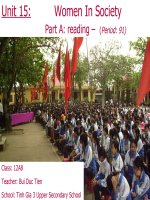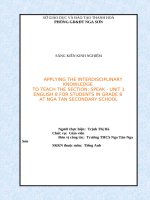Applying interdisciplinary knowledge in teaching part a reading unit 6 an excursion english 10 effectively
Bạn đang xem bản rút gọn của tài liệu. Xem và tải ngay bản đầy đủ của tài liệu tại đây (3.48 MB, 19 trang )
THANH HOA DEPARTMENT OF EDUCATION AND TRAINING
THACH THANH 2 HIGH SCHOOL
EXPERIENCE INITIATIVE
APPLYING INTERDISCIPLINARY KNOWLEDGE IN
TEACHING PART A- UNIT 6: AN EXCURSION
ENGLISH 10 EFFECTIVELY
Writer : Nguyen Thi Ha
Position: Teacher
Working place: Thach Thanh 2 High School
Research area: English
INDEX
Ordr
1
Table of contents
PART I: INTRODUCTION
Reasons for the research
Page
2
Purpose
1
3
Subject
1
4
Methods
2
1
PART II: CONTENTS
1
Theorical background
2
2
Realities before applying the research
2
3
Solutions
2
4
Effectiveness of the research
14
PART III: CONCLUSION
1
General conclusion
14
2
Recommendation
15
PART I: INTRODUCTION
1. Reasons for the research
Nowadays, learning English is becoming more and more important in
Vietnam as it is one of the core subjects in education system. Therefore, how to
make the method of teaching effective is very necessary for every English
Teachers. In fact, we can approach information and technology and have no
difficulties if we are good at speaking, listening, writing and reading. Specially,
reading is a basic skills that appears in all tests and examinations in Vietnam for
high school students. Students have chances to get information through the
passage. In addition, they also widen their knowledge of many other subjects
such as history, geography, culture etc. However, if students are bad at reading
skills, they find it very difficult to abtain the knowledge presented in the passage
and feel bored with learning this skills.
Having an English teacher at Thach Thanh 2 High school for several years,
my students’ reading skills is limited, they are not interested in learning this
skills if teacher always uses traditional methods,which makes them more and
more passive. What they have learned from passage is zero if they do not
practice again and again.
As we know that, applying interdisciplinay knowledge in teaching
languages is vital nowadays because it helps students improve their reading
skills. From my experience I think that in part A- reading- unit 6: An Excursion
is a suitable for applying this method of teaching. For these reasons, I choose the
topic of my research is “Applying interdisciplinary knowledge in teaching part
A- Reading unit 6: An excursion -English 10 effectively”
2. Purposes
As we know that, applying interdisciplinary knowledge in teaching
languages has become an effective method recently. It not only attracts students’
attention but also helps them understand the lesson easily and enrich their
knoledge in many other subjects such as history, geography, culture etc. Unit 6:
An excursion -English 10 gives them a lot of information about some tourism
destinations in Vietnam as well as hepls them be aware of protecting them and
be proud of our natural beauty of country.
Base on the innovation of the Ministry of education and Training about
applying interdisciplinary knowledge in teaching, I would like introduce some
new methods of teaching reading skill in part A- Reading unit 6: An excursion
English - 10
3. Subjects
In the research, I only focus on the 10 grade students who are going to learn
unit 6. Althoug the passage is a short of a letter, it contains some interseting and
useful some information about places such as Thien Mu pagoda, Thay pagoda,
Dalat, Ha Long bay- historical and tourism places. I will provide students with
some information related to these places. Which makes the interested in lesson,
showing some handout and organize game to make the lesson exciting.
1
4. Method
To make my method of teaching effective, I have used some techniques
below
- Firstly, I always get advices from my colleaguess through co-working
- Secondly, I search some pictures ,images, related to the topic of the lesson
in the Internet
+ pictures of some historical places: Thien Mu pagoda, Ha Long bay, Dalat,
Thay pagoda, One pillar pagoda
- Thirdly, I teach the lesson through real situations such as showing
pictures, real objects and I also learn how use powerpoint presentation,
projecters etc.
- Lastly, in the class, I aks students to work in groups in pair and guide
them to play some games to motivate their interest.
PART II. CONTENT
1. Theoretical Background
In teaching reading skills, teacher is considered to be successful when he
or she helps student be able to practice the words, do all the tasks in the texbook
correctly. Teaching units related to many other subjects is a hard work because it
reqiures teacher to have a lot of many general knowledge and spend much time
on the lesson. However, unit 6 part A reading is an interesting lesson and not
quite difficult. Therefore, I would like to use some new methods of teaching to
help my students understands this passage effectively.
2. Realities before applying the research
Some years ago, I applied these following steps to teach students:
1.
Before reading
- Warm up
. Present new words
. Practice with new words
2.
While reading
. Students read and do some tasks in the textbook and teacher corrects the
answers
3.
After reading
. Teacher or students summarize the main points of the lesson
4.
Homework
After spending 45 minutes teaching, I find that students can undersand the
lesson passively and they quickly foreget all. Moreover, the atmosphere of class
is so boring and students are tired of learning this skills again and again.
3. Solutions
To make the lesson more interesting, I have applied the method of teaching
below:
1. Warm up: Matching ( checking students’ knowledge about
interdisciplinay history, geography, cultural knowledge)
Teacher shows four pictures on screen and asks students to look at these
pictures and match them with suitable names
2
3
*
Students give the answer and teacher corrects them
+ picture 1: Thien Mu pagoda
+ picture 2: Ha Long bay
+ picture 3: One pillar pagoda
4
+ picture 4: Da Lat
Teacher asks students question: What do you know about these places?
Students : They are historical and tourism places
Teacher presents some more information about these places
Teacher introduces some new word by showing pictures or objects
1. Lotus
-Students’ answer: hoa sen
5
2. Picturesque
Students’ answer: đẹp như tranh
3. Pine forest
Students’ answer: rừng thông
4. Waterfall
6
Students’ answer: thác nước
Teacher leads in the new lesson: Today we are going to take part in an
excursion with Minh and Lan’ classmates to visit a pagoda in our country.
Teacher continues presents some new words in the passage
7
5. Cave /keiv/ (n): hang động
6. rock: đá (Students’ answer)
- rock formation: sự hình thành đá
8
Pagoda :chùa (Students’ answer)
7. Excursion: chuyến tham quan (Students’ answer)
9
- Campfire: lửa trại (Students’ answer)
Teacher practices these words and asks students to repeat.
2.Practice
T asks students to look at screen and listen carrefuly
Dear Minh,
10
I’m writing to tell you a piece of news. The first term is coming to an
end soon and my school is going to have some days off. On this occasion, my
class is visiting some caves near Hanoi as we have recently studied rock
formations. Besides, many of us have never been inside a cave, so I suppose
the trip will be very interesting.
At first, we wanted to travel to Thay Pagoda because it is only 20
kilometers away, and we could go on a day excursion.
However, only today have we learnt that the caves near Thay Pagoda
are closed until after Tet. So we are visiting the ones near Huong Pagoda
instead. A night campfire on a two-day trip will be a great event in our
schooldays! To make the trip cheap, we are bringing our own food and
sharing buses with some other classes.
It is much warmer now. I believe we’re going to enjoy good weather
with lots of sunshine.
The only problem I seem to have is getting my parents’ permission.
They may not want to let me stay the night away from home. I’ll try to
persuade them.
That’s all for now. Give my love to your parents and sister.
Yours,
Lan
After listening to tape of the passage, teacher asks students to work in pair
and do the task 1 in the textbook and then teacher checks the correct answers
Task 1
1.
Lan wrote the letter to ______
A. inform Minh of her days off
B. complain about her parents
C. tell Minh about the plan for her class trip
D. talk about what she and her classmates will do at Huong Pagoda
2.The students decided to go on an excursion because they wanted
to____
A. understand their geography lessons better B. relax after work
C. have a campfire
D. A and B
3.The students have changed their destination as ___Thay Pagoda
A. it is impossible to visit the caves near
B. it costs them a lot to visit
C. they prefer Huong Pagoda to
D. many of them have been to
Teacher shows a picture of Thay Pagoda, tells students about its location
and figures (checking students knwledge about history, geography and culture)
Thay pagoda is also called Thien Phuc Tu, it is located in Sai Son village, Quoc
Oai Destrist, Ha Tay province. It was buit more than 1000 years ago in Ly
dynastry. It has a shape of triangal. Every year, this pagoda attracts a lot of
visitors around the world because of its quietness and beauty.
11
Teacher : Now we are going to move to tasks 2
Task 2: Answer the questions
1. When are Lan and her classmates going on a trip?
2. Why are they visiting some caves?
3. How far is Thay Pagoda from their school?
4. What are the students’ plans for their trip to Huong Pagoda?
5. What is Lan anxious about? Why?
To make the lesson more dynamic and motivate students interest, I will organize
a game: Lucky number, introduces the rules of game, devides class into two
groups and ask students to take part in the game
*The rules*
Choose the number you like.
“There are 6 numbers in which each number has a different thing .The number
which has a
“Lucky number” word will give you 50 points without
answering the question.
“Question” word you will have to answer the question.
if you give the right answer to the question, you can get
different marks.
If the team can’t answer the question or gives incorrect answer , They will lose
their turn and move to the other. The team getting the highest marks will be the
winner.”
12
After the game ends, teacher gives the correct answers and declares the winer
1. When are Lan and her classmates going on a trip?
- When they have some days-off after the first term.
2. Why are they visiting some caves?
- Because they have recently studied rock formation and many of
them have never been inside a cave.
3. How far is Thay Pagoda from their school?
- It is only over 20 kilometres.
4. What are the students’ plans for their trip to Huong Pagoda?
- They are going to make a two-day trip and have a night campfire.
They are bringing their own food and sharing buses with some other
classes to make the trip cheap.
5. What is Lan anxious about? Why?
- She’s anxious about her parents’ permission. They may not want
to let her stay at night away from home.
3.Further practice ( checking students’ general knowledge)
Teacher shows a picture of a famous historical place in Thanh Hoa province and
asks students to guess its name and give some information about that place
Students will get: Citidal of Ho dynastry in Vinh Loc destrist, Thanh Hoa
province.
13
Teacher asks: What do you know about it?
Students may say it was built in Ho dynastry, it is very beautiful, it has four
gates: East gate, West gate, South gate and North gate.
Teacher adds The 14th century Ho Dynasty citadel, built according to the feng
shui principles, testifies to the flowering of neo-Confucianism in late 14th
century Viet Nam and its spread to other parts of east Asia. According to
these principles it was sited in a landscape of great scenic beauty on an axis
joining the Truong Son and Dong Son mountains in a plain between the Ma
and Buoi rivers. The citadel represents an outstanding example of a new
style of South-East Asian imperial city.
4.Homework
Teacher Asks students
- to learn by heart the new words
- to write a passage (100-120 words) about their favorite historical place in
Vietnam
- to prepare for part B- Speaking
Students: Write the requests on notebooks
4. Effectiveness of the research
To consolidate the lesson I had students to a 15 minutes test with ten multiple
choice questions on the worksheets. After 15 minutes I collected the papers,
gave marks and feedback.
From the results of applying my new solution in teaching, I realize that most
students understand and do well. Besides, most of them are interested in learning
from manipulaing interdisciplinary subjects which provides the students with a
wide range of information related to the lesson. Below is the statistics I have
collected from the school year 2018-2019 that my experiences have been done
in two classes 10C3 and 10C6 at Thach Thanh 2 High School.
Class Number Contents
Before appying/
After applying/
of
Rate (%)
Rate (%)
students
10C1
40
Excited
15
37, 5%
30
75%
Unexcited
25
62,7%
10
25%
10C6
42
Excited
15
35,07%
32
76,2%
Unexcited
27
64,93%
10
23,8%
PART III. CONCLUSION
1. General conclusion
In a lesson of teaching reading skill, the teacher not only helps students
understand the meaning of the passage but also manipulate plexibly techniques
which are agreeable with the instant unit to motivate students’s interest in
learning and create activities to make them practise better. However, English is
by far different from Vietnamese because it is too difficult to learn and
remember. Reading in Vietnamese is much easier as students do not get
difficulty in understanding the passage. Moreover, many students have a
14
limitation of words, some are lazy in practising at home or preparing the lesson
before going to school that prevent them from having good results.
Reading, writing and listening such a difficult lesson like unit 6 in Engish 10
requires students both having numerous words and phrases but also
understanding the culture of religion. And if they pay much attention to explain
correlative information, the content of the lesson will not be recoiled. What is
more, if they just cover on the content, there is little time for explaination.
Anyway, I have just presented my lesson plan from which I both teach my
students knowledge and manipulate disciplinary knowledge
2. Recommendation
* For my office and colleagues.
I would like to offer my office to invest more refererence books, hold English
clubs so that students have chances to practise and exchange knowledge more
often. I also take this hope that my colleagues will always cooperate and help
me in the process of teaching English at school.
* For Department of Education and Training.
I am looking for being paid attention to our teaching in a mountainous school as
mine that we feel interested in our career.
Being a young teacher, I know my research could be limited. I would like to
receive good comments from colleagues and sponsors so that my given solutions
become more perfect and effective.
Sincerely thank!
Approved by
I speak with full conviction that this is the
experience that I do it myself, not copying from
the others.
Thach Thanh, May 5th2019
Written by
Le Xuan Tuan
Nguyen Thi Ha
15
REFERENCES
1. SGV , SGK Tiếng anh 10 mới của Bộ GD-ĐT.
2. Tiếng Anh 10 hệ cơ bản , Hoàng Văn Vân, Nhà xuất bản Giáo dục Việt Nam.
3. Thiết kế bài giảng Tiếng Anh 10, Chu Quang Bình, Ha noi Press.
4. Jeremy Hammer “How to Teach English” Longman Press.
5. />6. Textbook: Đại Việt Sử Ký- Lê Văn Hưu
7. />8. />9. />10. />
16









